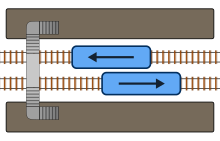Side platform
Side platform | ||||||||||||||||||||||||||||||||||||||||||
|---|---|---|---|---|---|---|---|---|---|---|---|---|---|---|---|---|---|---|---|---|---|---|---|---|---|---|---|---|---|---|---|---|---|---|---|---|---|---|---|---|---|---|
|
| ||||||||||||||||||||||||||||||||||||||||||
Station with two tracks and two side platforms
| ||||||||||||||||||||||||||||||||||||||||||




A side platform is a platform positioned to the side of one or more railway tracks or guideways at a railway station, tram stop, or transitway.[1] Dual side platform stations, one for each direction of travel, is the basic station design used for double-track railway lines (as opposed to, for instance, the island platform where a single platform lies between the tracks). Side platforms may result in a wider overall footprint for the station compared with an island platform where a single width of platform can be shared by riders using either track.[2][3]
In some stations, the two side platforms are connected by a footbridge running above and over the tracks.[2] While a pair of side platforms is often provided on a dual-track line, a single side platform is usually sufficient for a single-track line.
Layout
Where the station is close to a level crossing (grade crossing) the platforms may either be on the same side of the crossing road or alternatively may be staggered in one of two ways. With the 'near-side platforms' configuration, each platform appears before the intersection and with 'far-side platforms' they are positioned after the intersection.
In some situations a single side platform can be served by multiple vehicles simultaneously with a scissors crossing provided to allow access mid-way along its length.
Larger stations may have two side platforms with several island platforms in between. Some are in a Spanish solution format, with two side platforms and an island platform in between, serving two tracks.
See also
References
- ^ Parkinson, Tom; Fisher, Ian (1996). Rail Transit Capacity. Transportation Research Board. p. 24. ISBN 978-0-309-05718-9.
- ^ a b "Railway Station Design". Railway Technical Web Pages. Archived from the original on June 9, 2007. Retrieved August 19, 2016.
- ^ "Railway Platform and Types". Railwaysysyem.net. Retrieved 2017-06-30.
